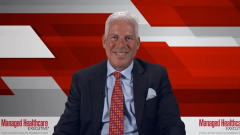Management of Anti-VEGF Agents for Wet AMD
Diana Do, MD, provides an overview of available anti-VEGF agents used in the treatment of wet AMD and Steven Peskin, MD, MBA, FACP, discusses management strategies employed with these agents.
Episodes in this series
Diana Do, MD: At this time, there are 4 available intravitreal VEGF inhibitors for the treatment of wet age-related macular degeneration [AMD]. The first VEGF inhibitor that was approved by the Food and Drug Administration was ranibizumab. This is an antibody to VEGF that is injected into the eye, and pivotal phase 3 clinical trials have shown its efficacy and safety for the treatment of wet age-related macular degeneration.
The second intravitreal VEGF inhibitor that was approved by the Food and Drug Administration was aflibercept. This VEGF inhibitor can be administered every 2 months to patients with wet age-related macular degeneration. The pivotal clinical trials also showed that aflibercept was very efficacious and safe for the treatment of wet age-related macular degeneration. Brolucizumab was most recently approved in 2019 for the treatment of wet age-related macular degeneration. This too is a VEGF inhibitor that is injected into the eye, and also had the potential advantage of being dosed every 3 months in the eyes with active wet AMD. However, most recently we’ve discovered that brolucizumab does have a higher risk of adverse events, such as intraocular inflammation, retinal vasculitis, and retinal artery occlusion, which could lead to irreversible vision loss. Another VEGF inhibitor that is actively used in clinical practice is bevacizumab. This medicine is used off-label but is also very efficacious and safe for the use of treatment in wet AMD. This medicine is usually dosed every month or used in a treat-and-extend regimen, and because it’s used off-label, it’s quite cost-effective compared with the other FDA-approved medicines.
In clinical practice, I’ve had very good success with the use of intravitreal VEGF inhibitors. In particular, when patients have prompt treatment and adhere to a very comprehensive and chronic follow-up regimen, I’ve seen that many patients can have a significant improvement in their visual acuity, and we can maintain this over many years. I use both on-label treatments such as ranibizumab or aflibercept, and I also use off-label bevacizumab for the treatment of this ocular disorder.
Steven Peskin, MD, MBA, FACP: Thinking about the strategies for management of persons with AMD and the choice of therapy, the lowest cost alternative, which has a lot of good clinical data and peer-reviewed literature supporting it, is bevacizumab. That product was brought to market for cancer treatment and is closely associated with 1 of 2 main therapies for wet AMD, Lucentis and Eylea. That’s our approach. We’re working again with a key retina subspecialist on value-based payment models where the retina specialist is, in a sense, given some economic consideration for using the best lowest-cost alternative. If that alternative is 1 of the more expensive branded products, so be it, because the clinical outcomes are of the greatest importance. If a person can be treated with a product that is 10, 20 times lower [in terms of cost] than 1 of the other products and effectively treated, then from a payer perspective, a societal perspective, and our health care professionals’ perspective with value-based payment models, that would be the best alternative.
With regard to bevacizumab as a step-through, it’s not a hard-step edit. It is certainly something from a specialty pharmacy that we will encourage. The program or approach that has proven to be the most effective with our clinical partners is to design a what we call an episode of care. Some folks refer to it as a bundle. That’s been the most effective way to get our retinal subspecialists to think about using bevacizumab as we’ll call it first line, and then for those persons who don’t tolerate or have a good response, then we move into other products, Lucentis and Eylea.
Transcript edited for clarity.
Newsletter
Get the latest industry news, event updates, and more from Managed healthcare Executive.
























































